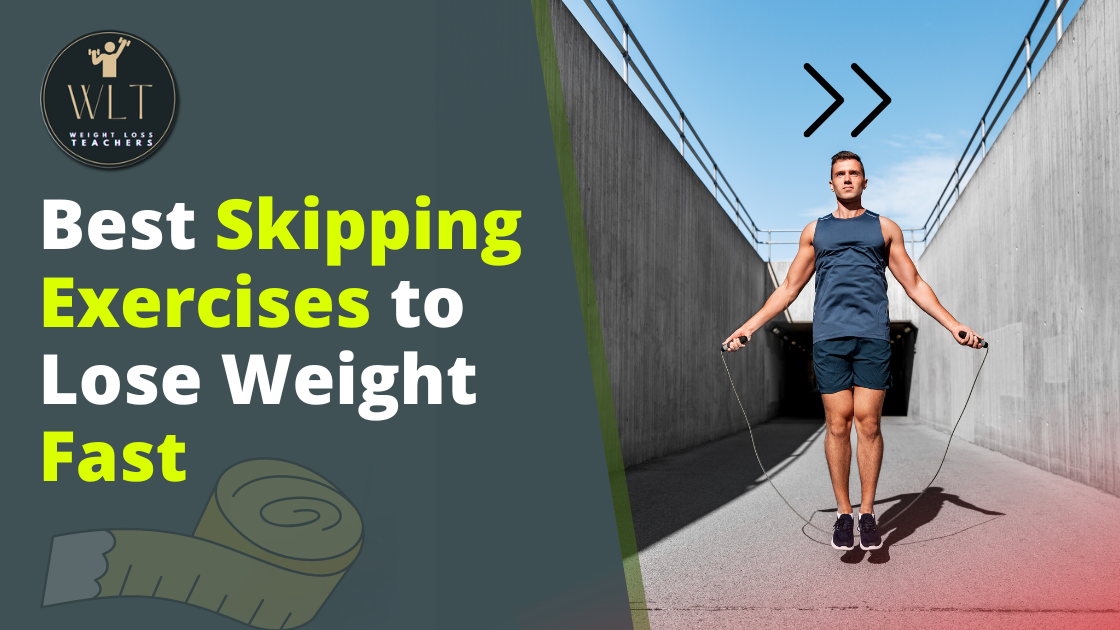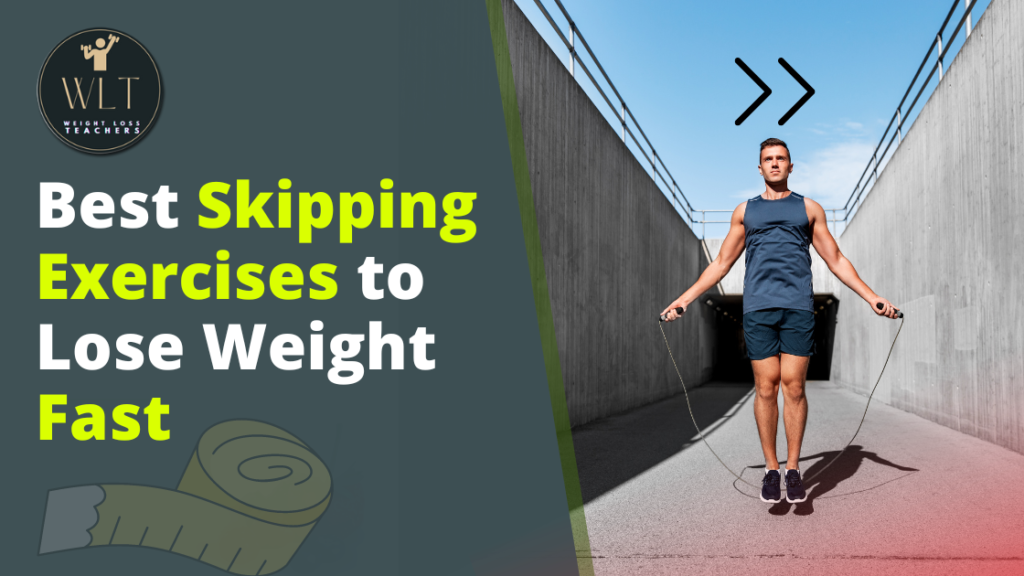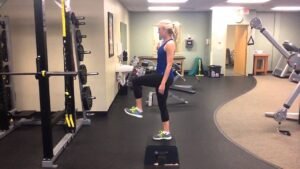
Best Skipping Exercises to Lose Weight Fast

Finding an efficient and pleasurable fitness activity is critical in today’s fast-paced society. Many individuals struggle to maintain a consistent workout regimen due to various factors such as time constraints, a lack of equipment, or the need for a convenient activity that can be done anywhere.
Table of Contents
Introduction
Skipping, an age-old activity enjoyed by both children and adults, provides numerous benefits for weight loss, cardiovascular health, coordination, and agility. As a fun and low-impact workout that requires no equipment, skipping can be done in the comfort of your own home, at a local park, or even during travel, making it an accessible option for individuals seeking to improve their fitness levels.
This article will delve into the world of skipping, investigating its various exercises and how they can be incorporated into a weight loss program. We will go in-depth on four skipping exercises to lose weight, highlighting their techniques, benefits, and tips for getting the most out of them.
Also, we will analyze the benefits of skipping exercises for weight loss and overall health, providing additional insights into the advantages and drawbacks of this versatile workout. Understanding the impact of skipping rope on weight loss and overall health allows you to make informed decisions about incorporating it into your fitness routine and achieving the best results.

Best Skipping Exercises to Lose Weight Quickly
The four most popular types of skipping exercises to lose weight are listed below.
The Basic Skip
The basic skip is the cornerstone for all other skipping exercises. It involves jumping with both feet over the rope and is an excellent cardiovascular exercise that can help you burn up to 10 calories per minute. This low-impact exercise is ideal for beginners because it is simple to execute and requires little coordination. The basic skip gives people a gentle introduction to the world of skipping, allowing them to develop their rhythm and coordination before moving on to more advanced skipping exercises to lose weight.

To do the basic skip:
- Stand with your feet together and hold the rope with both hands.
- Swing the rope overhead and jump with both feet over it.
- As you land, keep your feet together and your knees slightly bent.
- Keep your elbows close to your body and your wrists relaxed.
- Repeat the jump for 30 seconds to 1 minute.
Tips for performing the basic skip:
- Engage your core muscles and maintain a straight back throughout the exercise.
- Land softly on the balls of your feet to minimize the impact on your joints.
- Keep your shoulders relaxed and your head up to maintain proper form.
Double-Unders
Double-unders are advanced skipping exercises to lose weight that involves jumping over the rope twice for every single jump. This high-intensity exercise can help you burn up to 16 calories per minute, making it an effective calorie-burning option for weight loss. Double-unders require coordination, speed, and endurance, making them a challenging yet rewarding addition to your skipping routine. As you progress in your skipping journey, incorporating double-unders can provide a significant boost to your cardiovascular fitness and calorie expenditure.

To do double-unders, follow these steps:
- Stand with your feet together and hold the rope with both hands.
- Swing the rope overhead and jump with both feet over it.
- Swing the rope again and jump over it while rotating the rope twice.
- Land softly on the balls of your feet and repeat the jump for 30 seconds to 1 minute.
Tips for performing double-unders:
- Utilize your wrists to rotate the rope swiftly, maintaining a constant rhythm.
- Keep your arms close to your body and your elbows relaxed to minimize unnecessary movement.
- Jump high enough to allow the rope to pass under your feet twice, ensuring proper clearance.
Boxer Skip
The boxer skip mimics the footwork of a boxer, providing a dynamic and challenging skipping exercise. It is a high-intensity workout that can help you burn up to 12 calories per minute. By incorporating the boxer skip into your routine, you can enhance coordination, speed, and agility, all while supporting your weight loss goals. This exercise not only engages the cardiovascular system but also targets the muscles of the lower body and core.

To perform the boxer’s skip:
- Stand with your feet together and hold the rope with both hands.
- Jump to the left and swing the rope to the right.
- Jump to the right and swing the rope to the left.
- Jump forward and swing the rope over your head.
- Jump backward and swing the rope behind your feet.
- Repeat the pattern for 30 seconds to 1 minute.
Tips for performing the boxer skip:
- Throughout the exercise, keep your feet close together and your knees slightly bent.
- Maintain stability and control by engaging your core muscles.
- Maintain proper form by keeping your shoulders relaxed and your head up.
The Criss-Cross
The criss-cross is a skipping exercise in which you cross your arms in front of your body while jumping. It’s a high-intensity workout that can burn up to 14 calories per minute. You can improve your coordination, speed, and endurance by incorporating the criss-cross into your routine. This exercise adds a new dimension to your skipping exercises to lose weight by engaging new muscle groups and improving overall body control.

To do the criss-cross:
- Stand with your feet together and hold the rope with both hands.
- Swing the rope overhead and jump with both feet over it.
- As you jump, cross your arms in front of your body.
- Uncross your arms and swing the rope again.
- Repeat the jump and cross your arms the other way.
- Continue alternating the criss-cross pattern for 30 seconds to 1 minute.
Tips for performing the criss-cross:
- Keep your wrists relaxed and use your forearms to cross your arms smoothly.
- Jump high enough to allow the rope to pass under your feet, ensuring proper clearance.
- Maintain relaxed shoulders and keep your head up to maintain proper form.
High Knees
High knees are an excellent skipping exercise for weight loss that targets the muscles of the legs, particularly the quadriceps and hip flexors. It is a dynamic exercise that increases the intensity of your skipping routine while engaging the core muscles. High knees help elevate your heart rate, making it an effective cardio exercise for weight loss. Engaging the muscles of the legs and core also helps improve lower body strength and stability.

To perform high knees:
- Begin with a basic skip motion.
- As you jump, bring your knees up towards your chest as high as possible.
- Continue alternating legs and maintaining a fast pace for 30 seconds to 1 minute.
Tips for performing the high knees:
- Engage your core muscles to maintain stability and control throughout the exercise.
- Land softly on the balls of your feet to minimize impact and reduce stress on the joints.
- Keep your upper body relaxed and maintain an upright posture.
Side-to-Side Skip
The side-to-side skip is a great skipping exercise that targets the muscles of the inner and outer thighs. It adds variety to your skipping routine and provides a cardiovascular challenge while engaging the core muscles for stability. The side-to-side skip helps tone and strengthen the muscles of the inner and outer thighs, promoting better balance and stability. It also increases the intensity of your workout, aiding in calorie burning and weight loss.

To perform a side-to-side skip:
- Begin with a basic skip stance.
- Instead of jumping straight up, jump to the side, bringing your feet together.
- Immediately jump to the other side, alternating directions with each jump.
- Continue side-to-side jumps for 30 seconds to 1 minute.
Tips for performing the side-to-side skip:
- Engage your core and maintain a straight back throughout the exercise.
- Land softly on the balls of your feet with each jump to minimize impact.
- Keep your knees slightly bent and your shoulders relaxed.
Note: There might be affiliate links mentioned here. We may receive a commission if you purchase a product through an affiliate link. There is no additional charge for you. Please do your own research before making any online purchases.
Single-Leg Skip
The single-leg skip adds an extra balance and stability challenge to your skipping routine. It targets the muscles of the legs, especially the calves while enhancing coordination and proprioception. The single-leg skip helps improve balance, stability, and proprioception, which are essential for overall coordination. It also targets the calves, promoting strength and toning in these muscle groups.

To perform a single-leg skip:
- Start with a basic skip motion.
- Lift one leg off the ground, balancing on the other leg.
- Continue skipping with only one leg for 15 to 30 seconds, then switch legs.
- Repeat for 1 to 2 minutes.
Tips for performing the single-leg skip:
- Engage your core and maintain a straight posture throughout the exercise.
- Land softly on the balls of your feet with each jump.
- Start with shorter intervals and gradually increase the duration as your balance improves.
Running Skip
The running skip combines the motion of running with skipping, providing a higher-intensity workout that engages the entire body. It is an effective cardio exercise for weight loss and helps improve cardiovascular endurance. Running elevates your heart rate, promoting cardiovascular health and aiding in calorie burning. It also engages the muscles of the legs, core, and upper body, providing a full-body workout.

To perform a running skip:
- Begin with a basic skip motion.
- Increase the pace of your skipping, resembling a running motion.
- Lift your knees higher with each jump to simulate a running stride.
- Continue the running for 30 seconds to 1 minute.
Tips for performing the running skip:
- Maintain a strong core and upright posture throughout the exercise.
- Land softly on the balls of your feet, ensuring proper shock absorption.
- Engage your arms as you would while running to maintain balance and coordination.
Remember to warm up before attempting any intense skipping exercises, and modify the intensity and duration based on your fitness level. Additionally, consult with a healthcare professional if you have any underlying health conditions or concerns. By incorporating a variety of skipping exercises into your weight loss routine, you can keep your workouts engaging, challenging, and effective.
Benefits of Skipping Exercises for Weight Loss
Skipping exercises offer numerous benefits for weight loss and overall health. They provide a full-body workout that engages the legs, core, and arms, allowing for simultaneous calorie burning and muscle toning. Moreover, skipping rope for weight loss is a low-impact exercise, meaning it exerts less stress on the joints compared to high-impact exercises like running.
Let’s explore some of the key benefits of skipping exercises for weight loss:
- Burn Calories: Skipping exercises provides an excellent means of burning calories and facilitating weight loss. High-intensity skipping exercises like double-unders can help you burn up to 16 calories per minute, making them an efficient option for calorie expenditure.
- Increase Metabolism: Engaging in skipping exercises can elevate your metabolism, enabling you to burn more calories even during periods of rest. The energy demands of skipping exercises require your body to work harder, resulting in a heightened metabolic rate.
- Tone Muscles: Skipping exercises are dynamic and comprehensive, targeting multiple muscle groups simultaneously. By regularly incorporating skipping exercises into your routine, you can tone your leg, core, and arm muscles while shedding excess weight.
- Improve Cardiovascular Health: Skipping exercises provide an effective cardiovascular workout, boosting the heart rate and strengthening the heart and lungs. Consistent engagement in skipping exercises contributes to improved cardiovascular health and overall fitness.
- Enhance Coordination and Agility: Skipping exercises demand coordination and agility, making them an ideal means of enhancing balance and coordination. As you progress in your skipping routine, you’ll notice improvements in your overall coordination and agility, which can be beneficial for various physical activities.
- Portability and Convenience: One of the significant advantages of skipping exercises is their portability and convenience. Skipping can be done virtually anywhere, requiring minimal space and no specialized equipment. This accessibility ensures that you can maintain a consistent exercise routine regardless of your location or time constraints.
FAQs
Are skip exercises effective for weight loss?
Skipping exercises are high-intensity cardio workouts that can burn a significant number of calories. Skipping rope for weight loss engages multiple muscle groups and increases your heart rate, making it a powerful tool for weight management.
Can beginners do skipping exercises?
Yes, skipping exercises can be adapted for all fitness levels. Beginners can start with basic skips and gradually progress to more advanced variations of skipping rope for weight loss as they build coordination and stamina.
How many calories can I burn by skipping exercises?
The calorie burn varies based on the intensity and duration of your workout. High-intensity skipping exercises like double-under or crisscrosses can help you burn up to 10–16 calories per minute.
Do skipping exercises improve cardiovascular health?
Absolutely. Skipping exercises elevates your heart rate and enhances cardiovascular endurance. Regular practice strengthens your heart and lungs, contributing to better overall cardiovascular health.
Can I do skipping exercises if I have joint issues?
Yes, skipping rope for weight loss is considered a low-impact exercise that puts less stress on your joints compared to high-impact activities like running. However, it’s wise to consult a healthcare professional if you have existing joint issues before starting a new exercise routine.
How can skipping exercises enhance coordination?
Skipping exercises require rhythmic coordination between rope rotations and jumps. As you progress through various skipping variations, your coordination and proprioception improve, benefiting your overall balance and motor skills.
Can skipping exercises be done anywhere?
Skipping exercises require minimal space and equipment (just a jump rope). You can do them indoors, outdoors, at home, or while traveling, making them highly versatile and accessible.
Are there any risks associated with skipping exercises?
While skipping exercises are generally safe, improper technique or excessive intensity can lead to injury. It’s essential to start slowly, maintain proper form, and gradually increase intensity to avoid strain.
How often should I include skipping exercises in my routine?
The frequency depends on your fitness goals and overall routine. Aim for at least 3–4 times a week, gradually increasing the duration and intensity as your fitness improves.
Can skipping exercises help with muscle toning?
Yes, skipping engages various muscle groups, including the legs, core, and arms. Regular practice can lead to improved muscle tone and definition, especially when combined with a balanced diet and overall fitness program.
Conclusion
Incorporating skipping exercises into your fitness routine can lead to effective weight loss while improving overall health. The low-impact nature of skipping reduces joint stress, making it an accessible choice for individuals of various fitness levels. By embracing the basic skip, double-under, boxer skip, and crisscross, you can enjoy a full-body workout that targets multiple aspects of fitness. Remember to gradually increase intensity and duration as your strength and comfort level improve. Whether you’re a beginner or seeking a high-intensity challenge, skipping exercises offer a versatile and engaging approach to weight loss and improved well-being.
Disclaimer: The information provided in this article is for educational purposes only and should not be considered as a substitute for medical advice. Consult a healthcare professional before implementing any home remedies or making significant changes to your lifestyle.






